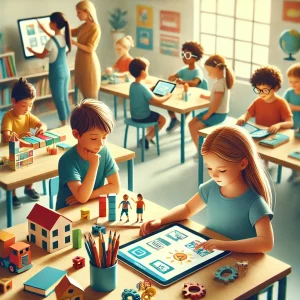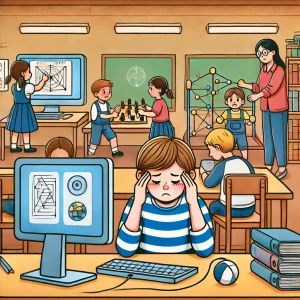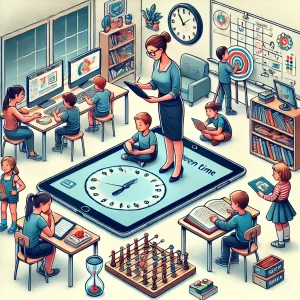
Last updated on 2024/06/19
Reading time : 5 minutes
How to integrate technology in a balanced and beneficial way in children’s education
Integrating technology into children’s education is a current topic in discussions at home and in classrooms.
While digital tools offer incredible learning opportunities, it is essential to use them in a balanced way to avoid potential pitfalls.
This article explores strategies for parents and educators to integrate technology beneficially into children’s education.

The benefits of technology in education
1. Access to a wealth of educational resources
Technology allows children to instantly access a vast array of educational resources.
From e-books to educational videos and interactive applications, children can explore topics that interest them and enrich their knowledge in an engaging and autonomous manner.
For example, platforms like “Khan Academy” and “Duolingo” offer free and interactive courses on various subjects, making learning more accessible and diverse.
2. Personalized learning
Technological tools adapt lessons to the needs and pace of each child, offering a personalization of learning that would be difficult to achieve in a traditional educational setting.
Educational applications like “DreamBox” and “IXL Learning” use algorithms to personalize content based on the child’s performance and progress, ensuring an effective and tailored learning experience.
3. Development of digital skills
Using technology prepares children for a digital world, allowing them to acquire essential skills such as online research, software proficiency, and a basic understanding of programming.
Initiatives like “Code.org” and “Scratch” enable children to get acquainted with programming from an early age, developing critical thinking and problem-solving skills.

The challenges of technological integration
1. Excessive screen time
The main challenge of using technology is the risk of excessive screen time, which can harm children’s health, causing visual fatigue, sleep disorders, and a sedentary lifestyle.
Studies show that prolonged screen time can also affect posture and lead to muscle and joint pain.
2. Inappropriate content
Unlimited Internet access can expose children to inappropriate content. It is vital to implement parental controls and monitor online activities to protect young users.
Software like “Qustodio” and “Net Nanny” can help parents filter content and monitor Internet use, ensuring a safe online environment.
3. Dependence and lack of social interaction
Excessive use of technology can reduce the necessary social interactions for children’s emotional and social development, potentially leading to dependence.
It is crucial to monitor signs of technological dependence, such as losing interest in offline activities and behavioral changes.

Strategies for balanced integration of technology
1. Establish screen time limits
It is essential to set clear limits for screen time, based on recommendations from the American Academy of Pediatrics, which advises limiting screen time to 1 to 2 hours per day for children aged 6 and older.
Additionally, it is recommended to plan regular breaks to avoid visual and physical fatigue.
2. Choose quality educational content
Selecting digital resources that offer real educational value is crucial to maximizing the benefits of technology.
Parents and educators can refer to recognized platforms and expert reviews to choose the best educational apps and websites.
3. Encourage active learning
Favor applications that require active interaction from children, promoting problem-solving and creativity.
For example, applications like “Tinkercad” and “Minecraft Education Edition” allow children to build and create, stimulating their imagination and critical thinking.
4. Integrate technology into daily activities
Using technology judiciously in daily activities can enrich the learning experience without being intrusive.
For instance, interactive cooking apps can help children follow recipes and learn culinary skills while using technology.
5. Encourage non-technical activities
It is also important to encourage children to engage in activities without technology, such as outdoor play, reading physical books, and artistic activities.
These activities contribute to children’s physical, cognitive, and emotional development, offering a healthy balance between digital and non-digital learning.
6. Model balanced behavior
Adults must set an example in terms of balanced use of technology, valuing screen-free periods and offline activities.
By establishing family rules regarding the use of electronic devices, parents can encourage responsible and moderate use of technology.

Integrating technology into children’s education in a balanced and beneficial way is possible with the right strategies.
By setting limits, selecting quality content, and encouraging active and diverse use, parents and educators can help children make the most of technology, making it a valuable tool for learning and development.
A balanced approach ensures that technology becomes an ally in children’s education, rather than a source of distraction or dependence.
Pauline Chabert
Pauline is our marketing manager at Koalia. Proud mother of 3 children, she runs our blog with her articles full of very useful resources!
You may also like
Download the Koalia mobile app

Start creating unique stories for your child!


